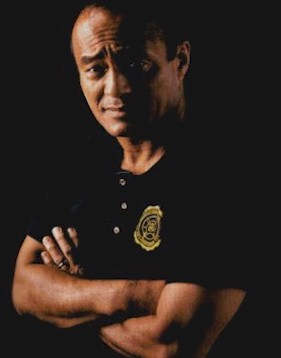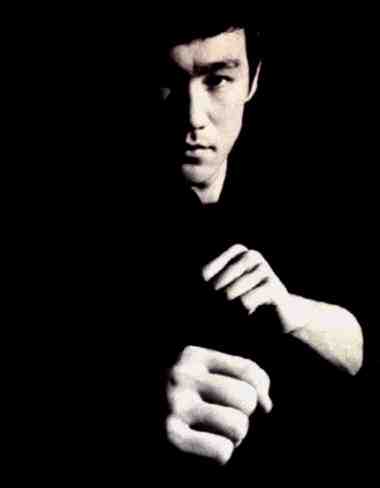Academy of Jeet Kune Do Fighting Technology
Athens
Greece
Jun Fan Jeet Kune Do Instructor
Vagelis Zorbas


Thai Boxing in Jeet Kune Do
 In order to
understand where Thai boxing fits into the puzzle that is known as jeet
kune do, we must first understand a little about the process by which JKD
evolved. The operative word here is "process." To quote Dan
Inosanto, "JKD is not about the product, but about the process."
When Bruce Lee first came to America, he quickly observed how much larger
and stronger the average American was compared to the average Chinese.
This was the original impetus that caused Lee to start the process of
modifying his mother art of wing chun. Between 1964 and 1973 Lee, with the
assistance of Dan Inosanto, dissected every fighting art that the two
could discover and selected elements that formed the foundation of what
would eventually be called jeet kune do. Not every aspect of every art was
included, of course.
In order to
understand where Thai boxing fits into the puzzle that is known as jeet
kune do, we must first understand a little about the process by which JKD
evolved. The operative word here is "process." To quote Dan
Inosanto, "JKD is not about the product, but about the process."
When Bruce Lee first came to America, he quickly observed how much larger
and stronger the average American was compared to the average Chinese.
This was the original impetus that caused Lee to start the process of
modifying his mother art of wing chun. Between 1964 and 1973 Lee, with the
assistance of Dan Inosanto, dissected every fighting art that the two
could discover and selected elements that formed the foundation of what
would eventually be called jeet kune do. Not every aspect of every art was
included, of course.
In certain cases, only training methods or combat theory were
extracted. This is the case with Western foil fencing, which lent its
concept of the "stop hit" (or interception) to JKD's combat
philosophy and, indeed, to JKD's very name (Way of the Intercepting Fist).
All systems of martial art have their strong and weak points. Bruce Lee
observed that, "There is a range in which Western boxing will counter
any kicking art; there is a range in which wing chun will counter boxing;
there is a range where tai chi will counter wing chun; and there is a
range where grappling will counter tai chi." In short, Lee chose
elements from the selected arts to give his students an integrated
framework that would prepare them to fight any opponent at any range.
Those who witnessed Lee at any of his closed-door sparring sessions saw
this principle in action. Limited by the vocabulary of their time, these
witnesses were never able to find a label for Lee. Sometimes he would
dance and shuffle at long range – boxing with his lead foot and hitting
the opponent at previously unknown angles, like an experienced savate man.
But if the opponent countered, Lee would bob and weave and throw body
shots like a professional boxer. Upon being blocked by the opponent, he
would shift into wing chun's chun choy (straight blast), trapping any
obstruction, pummeling with a flurry of elbows, knees, or head butts, and
ending the encounter with a foot sweep or throw. All of these difficult
elements would appear in a "match" that lasted just ten seconds!
Before his death, Lee, along with Inosanto, had been investigating muay
Thai extensively. After Lee's death, Dan continued the research with the
help of Chai Sirisute. We currently find three elements of Thai boxing to
be most useful in JKD.
The Thigh Kick
The thigh kick used by Thai boxers is perhaps the most formidable kick on
the planet. Thai boxers rely on their thigh kick much like a Western boxer
relies on his jab. One might say that this kick is the hub of their wheel.
Back in the late ‘60s and early ‘70s, low stances were very
common – martial artists of the time strongly favored stability over
agility. This facilitated Bruce Lee's use of the jeet tek (sidekick) to
the knee to intercept his opponent. Nowadays, we see boxing footwork more
often than low stances. This makes the knee a much more difficult target
to hit with a side kick. Therefore, many modern JKD practitioners also use
the thigh kick as a tool to intercept.
As we look at 90 percent of today's no-holds-barred contests, we
see that the thigh kick is predominant among winning fighters. For
example, one of the most highly acclaimed fights in the Ultimate Fighting
Championship's history was the bout between Maurice Smith and Mark
Coleman. Maurice Smith literally controlled the fight using the thigh
kick. Another example of the use of the thigh kick was the fight between
Marco Ruas and Paul "Polar Bear" Varelans. Again, the thigh kick
was the pivotal weapon, allowing Ruas to control the distance and cadence
of the entire match. These are just two examples (of many) of how potent
this weapon really is. To truly appreciate the power of the muay Thai
thigh kick, you simply must be on the receiving end of one! Many good Thai
boxers double up their kicks, executing two in a row. Landing multiple
thigh kicks in quick succession on the same area of the body is
nauseatingly painful. In short, if you have not already incorporated this
kick into your arsenal, start now!
The Thai Boxing Mindset
When I think of a Thai boxer, one thing comes to mind immediately: hard
core! These are some of the toughest people on Earth. Bruce Lee
incorporated the very same mentality into his trapping. Any martial artist
can take any aspect of his or her art and use the Thai boxer's mindset to
"hardcore" their particular art. For example, anyone can put on
a set of boxing gloves, poke shots at a partner, and call that boxing. But
if one truly wanted to "hardcore" his punches, he would find a
boxing gym and get in with an actual pro. The training regimen of a pro
(i.e. stamina, heavy-bag workouts, weight training, and sparring sessions)
is completely different from that of an amateur boxer.
It's one thing to roll around on the mat and practice arm locks,
triangles, and chokes. However, if you were to go to Brazil and train for
the Pan Am Games, then you'd be able to experience the hardcore side of
jiu-jitsu and appreciate it at an entirely different level! Many people
like to practice various trapping techniques working from reference points
only (or training exclusively on the wooden dummy). If these very same
people go to a professional boxing gym and recruit a pro boxer, put a
motorcycle helmet on him, and then spar full-contact while they try to
apply their trapping techniques, this would be an example of a wing chun
person applying the muay Thai hardcore mentality. In the world of stick
fighting, many people train themselves only – singly doing various
drills and disarms. These people could use the Thai boxing mentality to
"hardcore" their training by incorporating the use of lead pipes
or heavy sticks in their drills, and by sparring full contact.
To a jeet kune do practitioner, the Thai boxing mindset provides a
way to inject realism into his or her training. It is not enough to simply
practice the same drills day-after-day. When a martial artist knows that
he can go all out, take some punishment, and keep going, it does a lot for
his survival mentality. Anyone can benefit immensely from watching a good
Thai boxing match; however, this mentality is one attribute that is best
learned by experience. There are many great Thai boxers in the world – I
highly recommend investing the time, money, and courage to go and actually
train at one of the many Thai camps. If you think boot camp was tough, try
a Thai camp!
The Clinch
Being on the receiving end of a flurry of savate kicks is a very
intimidating prospect. Having a barrage of punches thrown at you by a
professional boxer is equally intimidating. Being stuck on the ground, in
the guard of a black belt Brazilian jiu-jitsu stylist, knowing that you
are seconds away from being put into an arm lock, triangle choke, or
sweep, is downright humiliating. However, being in the grasp of a
professional Thai boxer in clinch position is nothing less than sickening!
You can't go forward, you can't go backward, you have no balance or base;
and to make matters worse, you are being assaulted by two of the most
barbaric tools on Earth – elbows and knees. For the truly masochistic
martial artist, this is the coup de grace. It is not recommended for the
faint of heart! For a JKD stylist, the Thai boxing clinch is the most
natural position to end up in following the infamous straight blast. From
the clinch, he can execute tactics such as elbows, head butts, and knees,
or take an opponent to the ground if desired.
In closing, as we look back some 30 years, it is obvious that
Bruce Lee and Dan Inosanto were the pioneers of modern martial arts. They
understood then, what the world is seeing now – no one art, theology, or
philosophy has it all. No race or culture has a monopoly on the truth. We
can truly see that today's martial artists are harvesting knowledge from
seeds that were planted by Bruce Lee and Dan Inosanto. As each year
passes, people are becoming more open-minded and more eclectic; more
willing to live by the concept of "Absorb what is useful, reject what
is useless, and add what is specifically your own." In following this
adage, it's quite apparent that Thai boxing offers a wealth of techniques
both for JKD stylists, and martial artists of all systems, to absorb and
benefit from.
Paul Vunak is a certified Full Instructor of Jeet Kune Do and the Filipino Martial Arts under Dan Inosanto and is the president and head instructor of Progressive Fighting Systems. He can be contacted by phone at (949) 248-8999, or via his Web site at www.fighting.net.
